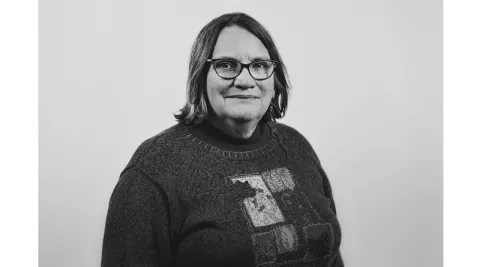SURF announces 2022 CORES Award recipient
Press release media

Photo by Adam Gomez
LEAD, SD— On Dec. 8, 2022, the Sanford Underground Research Facility (SURF) will recognize the monumental contributions of physicist and educator Peggy Norris with the 2022 CORES Award.
The CORES Award is given annually to an individual, group, business, or organization that supports Communication and OutReach Experiences in Science within the Black Hills region. Recipients demonstrate ongoing support for public outreach (whether through ongoing sponsorships, donations, or service) in a way that demonstrates a passion for science and a visible commitment to outreach.
“Peggy Norris’s dedication to science education is unparalleled,” said Constance Walter, SURF communications director. “Whether the audience is K-12 students or the general public, Peggy’s passion shines through. She fully embodies the spirit of the CORES Award and we are honored to present her with this award.”
“I am deeply honored to receive this award and am grateful to SURF management for their commitment to outreach, as well as to the many colleagues I worked with over the years while I was a member of the SURF E&O team,” Norris said. “I look forward to continued interactions with students of all ages in the future, whenever I am back home in South Dakota.”
While the Nobel Prizes will be given at a ceremony in Sweden on Dec. 10, SURF will present the CORES Award during its Nobel Day celebration, which will be held Thursday, Dec. 8, at the Sanford Lab Homestake Visitor Center. Norris is currently exploring Antarctica and will be unable to attend in-person; Norris’ daughter Molly Brown will deliver remarks and accept the prize on her behalf.
Full event and livestream information is available on our event webpage.
A career in physics, a calling for outreach
Norris received her doctorate in nuclear chemistry and the then-emerging science of lasers from Columbia University. In her class, she was joined by only one other female student. When she graduated with her doctorate, only seven percent of physicists in the United States were women. From this experience, Norris drew inspiration to equip women and other under-represented groups to pursue careers in STEM.
For 25 years, she worked as a staff scientist at Lawrence Berkeley National Laboratory, supporting nuclear physics research through the use of accelerators.
In 2009, Norris left Berkeley Lab for a position at a fledging research facility in the Black Hills of South Dakota. While the new facility had big goals for advancing physics research, she was more interested in inspiring the next generation of scientists. She joined the Education and Outreach (E&O) team at SURF, which focused on enhancing science education in classrooms across the state and region.
“At that time, we were trying to figure out what the identity of the education group should be and where our efforts would be most helpful to teachers and students,” Norris said.
As E&O deputy director, Norris has helped to build the team into a keystone for science educators in South Dakota. The team provides curriculum units, delivers in-school presentations, hosts field trips, and offers professional development programming—all at no cost to educators. In 2019, her final year at SURF before retiring, the team reached a total of 13,045 K-12 students and supported 779 K-12 educators from approximately 76 school districts.
After 14 years with the team, she retired from SURF’s E&O team earlier this year. In retirement, she continues to be a staunch advocate for STEM education for curious minds of all ages.
Norris uses phenomena from the natural world to get audiences excited about science. Her personal favorite phenomenon is a solar eclipse.
Norris has witnessed 16 solar eclipses on six different continents. She has chased Solar Eclipses from Australia to Svalbard Island, which lies 400 miles north of mainland Norway, above the Arctic Circle. Norris has traveled with groups to small towns and islands, even floated on the ocean to get near totality. She said that each eclipse is a unique experience and that she has seen a spectrum of phenomena linked to these galactic events.
“It takes your breath away,” Norris said. “There’s all these phenomena that can happen during a solar eclipse. You can have the diamond ring effect, where the last little tiny bit of light flashes like a diamond ring. Or you can have what's called Baily's beads, where you see light coming through the crater areas on the moon, looking like a string of beads.”
Norris has given presentations about eclipses to public audience around the state and region. In 2017, she led a group of students and space enthusiasts to watch a total solar eclipse in Nebraska with NASA’s Nationwide Eclipse Ballooning Project. At SURF’s citywide science festival Neutrino Day, she helps attendees peer safely at the sun through a solar telescope.
Norris planned a trip to Antarctica during the 2020 solar eclipse. The trip would have completed her mission to witness an eclipse on every continent. Due to the pandemic, the trip was rescheduled for this December. On Nobel Day, she will be joining us virtually from a cruise ship in the Antarctic Ocean.
Sanford Underground Research Facility is operated by the South Dakota Science and Technology Authority (SDSTA) with funding from the Department of Energy’s Office of Science. Our mission is to advance world class science and inspire learning across generations. Visit SURF at www.sanfordlab.org.